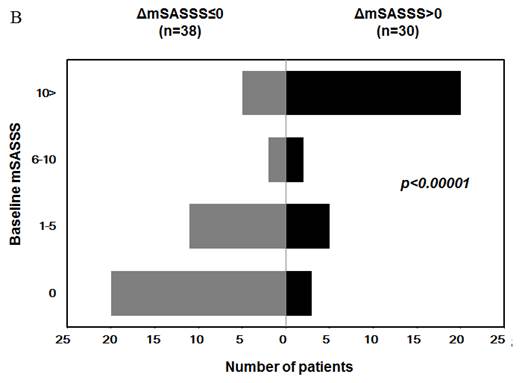Session Information
Date: Tuesday, November 10, 2015
Title: Spondylarthropathies and Psoriatic Arthritis - Clinical Aspects and Treatment Poster III: Therapy
Session Type: ACR Poster Session C
Session Time: 9:00AM-11:00AM
Background/Purpose: Ankylosing spondylitis
(AS) is a chronic rheumatic disease associated with radiographic damage of the
spine. Golimumab had consistent efficacy in controlling disease activity through
5 years but the benefit in preventing radiographic progression was obscure at
4-year. To predict radiographic progression, we analyzed baseline characteristics
of AS patients in Korean population.
Methods: All 68 Korean patients
with AS participated in the phase 3, multicenter, randomized,
placebo-controlled, double-blind trial which was previously described. Radiographic
evaluations were performed at baseline, week 104 and 208. Baseline modified
Stoke AS spine score (mSASSS) and change in mSASSS from baseline (¥ÄmSASSS) were
compared in the patients of Korea and other countries. Baseline characteristics
were compared between the patients with ¥ÄmSASSS>0 and ¥ÄmSASSS°Â0. The
correlation between baseline mSASSS and ¥ÄmSASSS was also analyzed.
Results: Korean patients had
lower baseline mSASSS and maintained consistently higher retention rate to
treatment (91.6% vs. 68.1%, p<0.0002) and assessment in AS partial
remission rate (44.4%
vs. 31.3%, p=0.036) till week 256 when compared to the patients in
other countries. However, ¥ÄmSASSS
was larger in Korean patients at week 104 and 208 without statistical
significance. Korean
patients who did not undergo radiographic progression of spinal lesion of AS
were younger when diagnosed and had shorter symptomatic duration, lower Bath AS
functional and metrology index, more chest expansion and lower baseline mSASSS.
The baseline mSASSS and ¥ÄmSASSS
had positive correlation in Korean AS patients (Spearman’s rho= 0.487, p<0.0001)
(Figure 1A). Radiographic progression was more prevalent (80%) when baseline mSASSS>10
and less common (13%) with baseline mSASSS=0 (Figure 1B).
Conclusion: Korean patients with
AS receiving golimumab had distinctive patterns of spinal lesion progression
detected by simple radiograph at week 208. This bipolar pattern of progression
could be predicted reliably by the initial severity of spinal lesion. Given
this result, this study implicated the value of early and active treatment
before appearance of overt spinal damage.
Figure 1.
Correlation between baseline mSASSS and ¥ÄmSASSS
at week 208 (Spearman’s rho) (A). Population distribution stratified by
baseline mSASSS and ¥ÄmSASSS at week 208 analyzed by Freeman-Halton
extension of the Fisher exact probability test (B).
To cite this abstract in AMA style:
Lee JS, Yu DY, Xu S, Lee EY. Baseline Extent of Damage at the Spine Predicts Radiographic Progression in Korean Patients Using Golimumab for Ankylosing Spondylitis [abstract]. Arthritis Rheumatol. 2015; 67 (suppl 10). https://acrabstracts.org/abstract/baseline-extent-of-damage-at-the-spine-predicts-radiographic-progression-in-korean-patients-using-golimumab-for-ankylosing-spondylitis/. Accessed .« Back to 2015 ACR/ARHP Annual Meeting
ACR Meeting Abstracts - https://acrabstracts.org/abstract/baseline-extent-of-damage-at-the-spine-predicts-radiographic-progression-in-korean-patients-using-golimumab-for-ankylosing-spondylitis/


